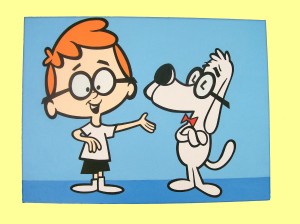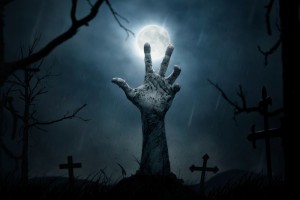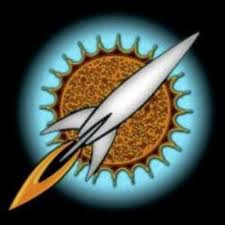 Note from Tom Joyce: This is a piece from writer C.I. Kemp that ran in a recent issue of “The Speculator,” the newsletter for the Garden State Speculative Fiction Writers, which I am re-posting here with Kemp’s permission. In retrospect, the connection between Mr. Peabody and H.P. Lovecraft seems obvious, in light of the fact … in light of the fact … Ah hell. I give up. There is no rational explanation for this. C.I. Kemp is freakin insane. Enjoy.
Note from Tom Joyce: This is a piece from writer C.I. Kemp that ran in a recent issue of “The Speculator,” the newsletter for the Garden State Speculative Fiction Writers, which I am re-posting here with Kemp’s permission. In retrospect, the connection between Mr. Peabody and H.P. Lovecraft seems obvious, in light of the fact … in light of the fact … Ah hell. I give up. There is no rational explanation for this. C.I. Kemp is freakin insane. Enjoy.
Peabody’s Improbable History: H.P. Lovecraft
by C. I. Kemp
 It’s common knowledge among horror aficionados that H.P. Lovecraft was strongly influenced by the works of Lord Dunsany and Edgar Allan Poe. There was, however, another individual without whose assistance Lovecraft would never have achieved the fame he did. Now at last, it can be told:
It’s common knowledge among horror aficionados that H.P. Lovecraft was strongly influenced by the works of Lord Dunsany and Edgar Allan Poe. There was, however, another individual without whose assistance Lovecraft would never have achieved the fame he did. Now at last, it can be told:
Note: If you’re one of the few who had a deprived childhood and grew up without ever seeing an episode of “Peabody’s Improbable History,” please check it out on You Tube before reading further. That way, you can appreciate the deathless prose that follows with all the seriousness and respect it deserves.
FADE IN
Opening animation to PEABODY’S IMPROBABLE HISTORY accompanied by theme music.
DISSOLVE TO:
1. INTERIOR: Peabody’s lab.
Peabody is standing in front of the the WABAC Machine, Sherman by his side.
PEABODY
Hello there. Peabody here. (Gesturing) Sherman and WABAC there. Sherman is a boy. The WABAC – a time machine.
SHERMAN
Where are we going today, Mr. Peabody?
PEABODY
Set the WABAC for the year 1926.
SHERMAN
And the place?
PEABODY
Providence, Rhode Island, where we’ll meet that illustrious horror writer, Howard Phillips Lovecraft.
2. EXTERIOR. A street scene in Providence, RI.
PEABODY (voice-over)
In less time than it takes to tell, the WABAC Machine transported us to Lovecraft’s doorstep.
An angry mob is gathered outside a house. They’re throwing rotten fruit through the windows and shouting in anger. From inside the house comes a loud discordant singing:
LOVECRAFT (voice-over)
Lullaby and good night! La la la la la la la…
SHERMAN
Golly! What’s going on, Mr. Peabody?
PEABODY
I think it’s time we found out.
PEABODY (voice-over)
Sherman and I entered the house and found…
3. INTERIOR – Lovecraft’s bathroom.
Lovecraft is standing before a large bathtub, holding a piece of sheet music and singing off-key. In the tub is Cthulhu, happily splashing about, playing with a decapitated rubber duck, making unintelligible gurgling sounds. The walls are plastered with the remains of thrown fruit as are Lovecraft’s face and lapels.
PEABODY (voice-over continues)
…Lovecraft singing to a many-tentacled, winged, big-footed sea monster.
LOVECRAFT (to the tune of Brahms’ Lullaby)
Go to sleep, go to sleep… Oh, it’s no use, I’m ruined!
PEABODY
Why the long face, Mr. Lovecraft?
LOVECRAFT (gesturing at his gaunt face)
Why, I was born with it.
PEABODY
No, no, I mean, why so unhappy?
LOVECRAFT
Oh, it’s because of him (gesturing at Cthulhu)
PEABODY
I don’t understand.
LOVECRAFT
Well, listen to this. (Clears throat). “In his house at R’lyeh dead Cthulhu waits dreaming.”
SHERMAN
Why, that’s wonderful!
LOVECRAFT
Yes, but I can’t use it.
PEABODY
And why is that?
LOVECRAFT
Well, one can’t dream unless one is asleep, right?
PEABODY
Right.
LOVECRAFT
And one can’t sleep if one won’t go to sleep, right?
PEABODY
Also right.
LOVECRAFT
Well, I can’t get him to go to sleep!
Camera shifts to Cthulhu who is squeezing the rubber duck. The duck flies out of his tentacles…
Camera shifts back to Lovecraft.
…and hits LOVECRAFT in the head before bouncing off-screen.
PEABODY
Well, your singing doesn’t seem to be bearing fruit.
LOVECRAFT
Oh, I wouldn’t say that. (He picks a remnant of fruit from his lapel and starts chomping.) May I offer you an apple?
PEABODY
No thank you. What I mean is your lullaby doesn’t seem to be making him sleepy.
LOVECRAFT
You’re right. Perhaps some Nelson Eddy show tunes? When I’m calling youuuuuuu…
PEABODY and SHERMAN are wincing, covering their ears. CTHULHU is holding his tentacles to where his ears might be and is making some very unhappy gurgling sounds.
PEABODY
I think not. Might I recommend some more traditional methods?
LOVECRAFT
Such as?
PEABODY
Warm milk has been shown to be an effective sleep inducer. Why not try that?
LOVECRAFT
Excellent idea!
4 EXTERIOR – A nearby farm
PEABODY, SHERMAN, LOVECRAFT, and CTHULHU are standing outside of a barn.
PEABODY (voice-over)
I directed Lovecraft to a nearby dairy farm. Naturally, a simple glass of warm milk could hardly have any effect on a creature Cthulhu’s size…
5 INTERIOR – Barn
An assembly line of cows goes past Lovecraft, seated on a stool, as he milks each one.
PEABODY (voice-over)
…so Lovecraft proceeded to milk a barn full of cows.
6 EXTERIOR – Barn.
PEABODY and SHERMAN are standing outside of the barn. Suddenly, there is a loud THUD, a yell, and a dazed and battered Lovecraft comes crashing through the wall of the barn and landing on his butt before PEABODY and SHERMAN.
SHERMAN
Mr. Lovecraft, what happened?
LOVECRAFT
That last one was a bull.
7 INTERIOR – Barn
CTHULHU is downing bucket after bucket.
PEABODY (voice-over)
Cthulhu proceeded to swallow bucket after bucket of the milk. The result, however, was not what we had hoped for.
CTHULHU
(Loud) Moo! (Louder) BUUURRRRP!
CTHULHU leaps off-screen…
8 EXTERIOR – A water trough outside the barn.
…and onscreen again into the water trough where he begins splashing and making happy gurgling sounds, much as we saw him in the earlier bathtub scene. PEABODY, SHERMAN, and LOVECRAFT are standing by.
SHERMAN
What do we do now, Mr. Peabody?
PEABODY (stroking his chin)
Hmmmmm. I think a more scientific approach is called for.
9 INTERIOR – A local pharmacy
All four are standing in the pharmacy in front of an aisle with a sign reading “Sleep Aids.”
Scene shifts to CTHULHU proceeding down the aisle devouring everything off the shelves.
PEABODY (voice-over)
We then proceeded to a local pharmacy where Cthulhu availed himself not only of the various sleep aids, but everything else in the store.
Once again, Cthulhu makes a grand leap off-screen.
10 EXTERIOR – A street scene
Several little kids are playing at an open fire hydrant. They look up and flee in terror as Cthulhu lands in the puddle and resumes his splashing and gurgling.
PEABODY (voice over)
Unfortunately, Cthulhu remained as animated as ever.
11 EXTERIOR – Outside the pharmacy, which now has an “Out Of Business” sign in the window.
LOVECRAFT
Oh, it’s no use! I’ll never be able to write at this rate! I may as well go into some other line of work.
SHERMAN
Like what, Mr. Lovecraft?
LOVECRAFT
I don’t know. Tuba Instructor? Yogurt Taster? (Shudders) Insurance Salesman?
PEABODY (voice-over)
Lovecraft’s suggestions gave me an idea.
PEABODY
Mr. Lovecraft, if you follow my instructions, I can not only get Cthulhu to go to sleep, but I can guarantee to keep him asleep for a very long time.
LOVECRAFT
You can? How?
12 EXTERIOR – A different street scene.
PEABODY and LOVECRAFT enter a storefront office whose sign reads “Justin Cayce, Insurance.” After a few seconds, they leave with LOVECRAFT carrying a brief case.
PEABODY (voice-over)
I got Lovecraft to apply for a job with the local insurance agent. In no time, Lovecraft was conferring with his first client…
13 INTERIOR – Lovecraft’s house.
LOVECRAFT and CTHULHU are sitting at a table across from each other. LOVECRAFT’S briefcase is open and he is chattering at high speed to CTHULHU while riffling through a voluminous sheaf of papers. As LOVECRAFT speaks, CTHULHU’s yawns become progressively longer and deeper. At the end of PEABODY’S voice-over, CTHULHU’S head plunks down on the table and he emits loud snores,.
PEABODY (voice-over)
…Cthulhu. As Lovecraft explained the subtleties of Liabilities and Deductibles, Cthulhu’s eyelids began to droop. By the time Lovecraft was elaborating on the differences between Term and Whole Life, Cthulhu was dead to the world.
14 EXTERIOR – Lovecraft’s house.
A large crate labeled “To R’lyeh” is being loaded onto a UPS (Ulthar Package Senders) truck.
PEABODY (voice-over)
From there, it was a simple matter to ship Cthulhu to R’lyeh.
15 INTERIOR – Lovecraft’s house.
LOVECRAFT is sitting at a table, pounding away at a typewriter with a beatific (and somewhat silly) smile.
PEABODY (voice-over)
As for Lovecraft, he was able to go back to his writing.
16 INTERIOR – PEABODY’S lab.
PEABODY and SHERMAN are sitting in easy chairs across from each other.
SHERMAN
Boy, it’s sure lucky Mr. Lovecraft got that insurance job.
PEABODY
Indeed it is. Lovecraft proved quite successful at it, too. So much so, in fact, that he was transferred to the Innsmouth office where he was assigned to shadow people as an investigator for the company.
17 EXTERIOR – A low aerial view of Innsmouth buildings.
LOVECRAFT is seen skulking along rooftops.
18 INTERIOR – PEABODY’S lab.
PEABODY
In fact, he became so skilled that he became known…
SHERMAN
Mr. Peabody! It can’t be!
PEABODY
Oh, but it is. Lovecraft became known as (slight pause) the Shadower Over Innsmouth.
SHERMAN winces. A discordant trumpet blat sounds. Closing theme.
FADE OUT.
 Well, it’s been a long haul. Been dealing with some stuff. (See last blog entry.) But somewhere in there, the Oct. 31 release date for my short story collection, “The Devil’s Kazoo Band Don’t Take Requests,” crept up on me. So I guess now’s as good a time as any to blow the dust off this blog and post something. A while back, I found some two-sentence horror stories on the web. Here’s an example:
Well, it’s been a long haul. Been dealing with some stuff. (See last blog entry.) But somewhere in there, the Oct. 31 release date for my short story collection, “The Devil’s Kazoo Band Don’t Take Requests,” crept up on me. So I guess now’s as good a time as any to blow the dust off this blog and post something. A while back, I found some two-sentence horror stories on the web. Here’s an example: Great weekend! I spend most of it at PhilCon — the Philadelphia Science Fiction Conference. Actually held in Cherry Hill, N.J. But I guess PhilCon is too august a name to change lightly. This event has been going on in one form or another since 1936.
Great weekend! I spend most of it at PhilCon — the Philadelphia Science Fiction Conference. Actually held in Cherry Hill, N.J. But I guess PhilCon is too august a name to change lightly. This event has been going on in one form or another since 1936. This piece originally appeared in the quarterly newsletter for the Garden State Speculative Fiction Writers, which I edit. I thought it would be of benefit to the science fiction writers in our group. But I think horror writers could find plenty of material here. Bottom line — the existence of alien lifeforms in the universe is pretty much a statistical certainty. And they’re probably a lot more like something out of H.P. Lovecraft’s imagination that Gene Roddenberry’s. *Shudder* By the way, the eye-popping photos that accompany this are from the Hubble Telescope.
This piece originally appeared in the quarterly newsletter for the Garden State Speculative Fiction Writers, which I edit. I thought it would be of benefit to the science fiction writers in our group. But I think horror writers could find plenty of material here. Bottom line — the existence of alien lifeforms in the universe is pretty much a statistical certainty. And they’re probably a lot more like something out of H.P. Lovecraft’s imagination that Gene Roddenberry’s. *Shudder* By the way, the eye-popping photos that accompany this are from the Hubble Telescope.





